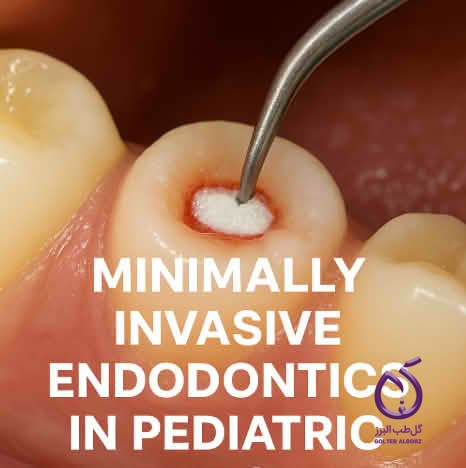Understanding MID: How It Relates to Pulpotomy and Pulp Capping
2025-08-04 17:09:40

🦷 What is Minimally Invasive Dentistry (MID)?
Minimally Invasive Dentistry is a modern, preservation-oriented approach focused on maintaining as much of the natural tooth structure as possible. Instead of extensive removal of tooth tissue, this method emphasizes early detection, prevention, and conservative restorations to maintain function and aesthetics with minimal intervention.
🎯 Core Principles of MID:
Prevention is better than cure: Emphasis on plaque control, fluoride therapy, oral hygiene education, and dietary guidance.
Early diagnosis: Use of digital tools, lasers, loupes, and CBCT to detect caries and diseases at their earliest stages.
Targeted caries removal: Only infected dentin is removed, preserving remineralizable dentin.
Use of biocompatible materials: Such as adhesive resins, glass ionomers, and bioceramics to restore teeth with minimal tissue removal.
Reinforce and regenerate, not replace: The goal is to preserve the pulp and avoid aggressive treatments like root canals or tooth extraction.
🛠️ Common MID Techniques:
| Technique | Description |
|---|---|
| Sealants | Covering tooth fissures to prevent decay |
| Fluoride Therapy | Remineralizing early demineralized enamel |
| Biological Pulpotomy | Preserving vital pulp using bioactive materials like MTA or Biodentine |
| Adhesive Direct/Indirect Restorations | Minimal tooth preparation required |
| Smart Excavation | Removing decay with intelligent tools or hand instruments, avoiding damage to healthy dentin |
| Air Abrasion / Micro Abrasion | Precise decay removal using powder or laser without traditional drilling |
📌 Specific Applications:
-
Pediatric Dentistry: Conservative pulpotomy, fluoride therapy, use of sealants
-
Endodontics: Pulp capping, apexogenesis, biological treatments instead of full pulp removal
-
Periodontics: Non-surgical initial therapy and tissue regeneration using lasers or PRF
-
Restorative & Aesthetics: No-prep or minimal-prep restorations, ultrathin veneers
🔍 The Philosophy of MID: Changing the Mindset
Traditional dentistry followed a "drill and fill" model. MID introduces a paradigm shift:
"Healthy tooth structure is more valuable than any restorative material."
This philosophy applies not only to caries treatment but also to endodontics, periodontics, aesthetics, and pediatric dentistry.
📈 Innovations Supporting MID
| Technology | Role in MID |
|---|---|
| CariVu / DIAGNOdent | Early caries detection without radiation |
| High-resolution CBCT | 3D analysis of lesion volume and pulp proximity |
| Dental Loupes & Microscopes | Precise caries removal with minimal cutting |
| Erbium / Diode Lasers | Accurate hard and soft tissue removal with minimal heat |
| Smart Materials | pH-responsive, fluoride-releasing, or bioactive sealers |
🧩 Challenges & Limitations of MID
-
Requires highly accurate diagnostics – misdiagnosis may leave infected tissue behind
-
Demands advanced skills for adhesive or bio-based restorations
-
Limited applicability in severely damaged teeth – more invasive treatment may be necessary
-
Requires patient cooperation – especially in children or anxious individuals
🔄 MID and Its Link to Bioactive Dentistry
Bioactive dentistry complements MID through the use of materials like:
-
MTA, Biodentine, CEM Cement
-
Resin-modified glass ionomers
-
Fluoride-releasing sealants
These materials are not only biocompatible but also promote natural healing and tissue regeneration.
🧠 The Future of MID: Integrating AI and Personalized Dentistry
-
AI-based algorithms to assess caries risk and suggest conservative treatments
-
Saliva and oral microbiome profiling to guide material selection
-
Patient education apps to improve prevention and compliance
🦷 Minimally Invasive Endodontics (MIE)
Minimally Invasive Endodontics refers to diagnostic and therapeutic approaches aimed at preserving the tooth structure, maintaining pulp vitality when possible, and minimizing the removal of healthy tissue during root canal treatment.
✅ Ultimate goal: Preserve a vital or functional tooth, reduce structural weakening, and enhance the long-term prognosis of the treated tooth.
🔍 Core Principles of MIE:
-
Early Diagnosis & Conservative Pulp Therapy:
-
Using CBCT, vitality testing, and digital tools to assess pulp status accurately
-
If pulp is still vital → consider treatments like:
Direct Pulp Capping
-
Definition: A vital pulp therapy where a biocompatible material is placed directly over exposed pulp (due to caries removal or trauma) to protect it and stimulate dentin bridge formation.
-
Indications: Small, clean mechanical exposures; controlled bleeding; healthy pulp without irreversible inflammation
-
Materials: MTA, Biodentine, CEM Cement
-
Notes: Requires a sterile field and no active bleeding; best results in immature permanent teeth
Indirect Pulp Capping
-
Definition: When caries is near the pulp but without exposure, some soft dentin is left to avoid exposure, and a bioactive antibacterial material is placed to encourage dentin regeneration and pulp protection.
-
Indications: Deep caries in permanent or primary teeth; vital pulp with no spontaneous pain or swelling
-
Materials: Resin-modified glass ionomer, calcium hydroxide (historically), Biodentine, TheraCal LC
-
Outcomes: Studies show longer success rates in some cases compared to full pulp removal; ideal for MID
Partial or Full Pulpotomy (using MTA or Biodentine)
-
Definition: Removal of part or all of the coronal pulp in teeth with vital but affected pulp, aiming to preserve radicular pulp.
-
Partial Pulpotomy (Cvek): Removes only 1–3 mm of inflamed pulp tissue
-
Full Pulpotomy: Removes all chamber pulp while keeping root pulp intact
-
Indications: Trauma or deep caries exposure with vital pulp and controllable bleeding; immature permanent teeth for apexogenesis
-
Materials: MTA, Biodentine, CEM Cement
-
Notes: Encourages continued root development and apex closure in immature teeth; preserves vitality in mature teeth as an alternative to full root canal
Clinical Tip:
| Treatment | Main Advantage | Best Indications |
|---|---|---|
| Direct Pulp Capping | Full pulp preservation | Clean mechanical exposure |
| Indirect Pulp Capping | No pulp exposure | Deep caries near pulp |
| Partial/Full Pulpotomy | Inflammation control & root preservation | Trauma or reversible pulpitis |
-
Conservative Access Cavity:
-
Minimal removal of crown and chamber floor
-
Preservation of buccal and lingual cusps to prevent crown fractures
-
Minimal Canal Shaping:
-
Use of low taper files (e.g., .04 or less)
-
"Shape less, clean more" philosophy – focus on effective irrigation instead of over-enlargement
-
Advanced Irrigation Systems:
-
Activating irrigants using:
-
Sonic (EndoActivator)
-
Ultrasonic (Irrisafe, Ultrasonic Tips)
-
Laser (PIPS, SWEEPS)
-
-
Common irrigants: NaOCl, EDTA, CHX, or dual systems
-
Conservative and Biocompatible Obturation:
-
Using bioceramic sealers (e.g., C-Root BP, EndoSequence, BioRoot RCS)
-
Single cone technique with bioactive sealer – no need for excessive pressure
📌 Benefits of Minimally Invasive Endodontics:
-
Reduced risk of structural fracture
-
Long-term preservation of dentin
-
Lower risk of iatrogenic errors (e.g., perforation, ledging)
-
Ideal for teeth with thin walls, open apices, or young patients
-
Compatible with regenerative endodontic therapies
🔬 Clinical Scenarios:
| Condition | Suggested MID Approach |
|---|---|
| Vital pulp with mechanical exposure | Direct pulp capping with MTA or Biodentine |
| Immature permanent tooth with pulp necrosis | Apexogenesis via pulpotomy or regeneration |
| Deep caries near the pulp | Selective caries removal and bioactive coverage |
| Narrow canal with curvature | Minimal shaping with activated irrigation |
🧠 Challenges:
-
Accurate pulp vitality diagnosis
-
Need for magnification (microscope/loupes) for conservative access
-
Moisture and contamination control in closed environments
-
Proper selection of biocompatible and reliable materials
🔮 Future of Minimally Invasive Endodontics:
-
Nano-Endodontics: Using nanoparticles for enhanced canal disinfection
-
File-free Endodontics: Combining chemical dissolution with advanced irrigation
-
Artificial Intelligence: CBCT image analysis, treatment outcome prediction, and clinical decision support
❓ Question – What are the similarities and differences between Vital Pulp Therapy (VPT) and Minimally Invasive Dentistry (MID)?
✅ Answer:
-
Vital Pulp Therapy (VPT) refers to:
✅ Treatments such as:
-
Direct pulp capping
-
Indirect pulp capping
-
Partial or full pulpotomy
With the goal of maintaining pulp vitality and avoiding full root canal treatment.
-
Minimally Invasive Dentistry (MID) refers to:
✅ A set of principles and techniques aiming to:
-
Maximize preservation of the natural tooth structure (enamel, dentin, pulp)
-
Detect disease early
-
Intervene conservatively
-
Emphasize preventive strategies
🔁 Key Differences Between VPT and MID
| Aspect | Vital Pulp Therapy (VPT) | Minimally Invasive Dentistry (MID) |
|---|---|---|
| 🎯 Main Goal | Preserve the vitality of the pulp in affected teeth | Preserve the natural structure even before damage occurs |
| 🔍 Treatment Focus | Pulp – prevent necrosis or restore health | Enamel, dentin, pulp – early prevention and conservative treatment |
| 🔬 Timing of Intervention | When the pulp is at risk | Before major damage – more preventive in nature |
| 🛠️ Treatment Types | Pulp capping, pulpotomy, apexogenesis | Sealants, early caries control, minimal tissue removal |
| 🧪 Common Materials | MTA, Biodentine, CEM cement | Glass ionomer, resin composite, fluoride, CPP-ACP |
| 🤝 Root Involvement | Yes – often used in immature teeth | Not necessarily – can be coronal only |
❓ Question – What is meant by “biocompatible materials” in sealers and pulpotomy treatments?
✅ Answer:
Biocompatible materials are those that:
-
Are non-toxic to living pulp or periapical tissues
-
Do not provoke a strong inflammatory or immune response
-
Support natural healing and regeneration (e.g., dentin bridge or cementum formation)
📦 Examples of Biocompatible Materials in VPT or MID:
| Material | Type | Biocompatibility Features | Applications |
|---|---|---|---|
| MTA (Mineral Trioxide Aggregate) | Bioceramic cement | Highly biocompatible, antibacterial, stimulates dentin bridge | Pulpotomy, pulp capping, apexification |
| Biodentine | Tricalcium silicate | Biocompatible, strong mechanical properties, faster setting than MTA | Alternative to MTA in VPT |
| CEM Cement | Calcium-phosphate cement | Biocompatible, cost-effective, popular in Iran | Pulpotomy, apexogenesis |
| C-Root BP / EndoSequence | Premixed bioceramic sealer | No toxic ions, moisture-activated | Pulpotomy, perforation repair |
| TheraCal LC | Light-cured calcium-releasing resin | Calcium release, visible-light cure | Direct pulp capping |
❌ On the other hand, non-biocompatible or toxic materials (now discouraged):
-
Formocresol → Highly cytotoxic, potential carcinogen
-
Traditional calcium hydroxide → Can cause internal resorption, weak seal
-
Zinc oxide-eugenol → May cause inflammation when in contact with vital pulp
🎯 Conclusion:
When we say "minimally invasive pulpotomy with biocompatible materials," we mean preserving the vital pulp and using materials like MTA or Biodentine instead of removing all pulp tissue and performing full root canal therapy. This preserves both pulp vitality and tooth strength.
Latest Articles
Video demonstration of endodontic treatment in a mandibular molar with multiple canals and curved roots
Read more
Get to Know the Endomotor Endowiseplus and Learn How to Use It
Read more
Practical training on the use of OraAid adhesives on a dental model
Read more
Do you know the role of silicone stops in endodontic treatments?
Read more





